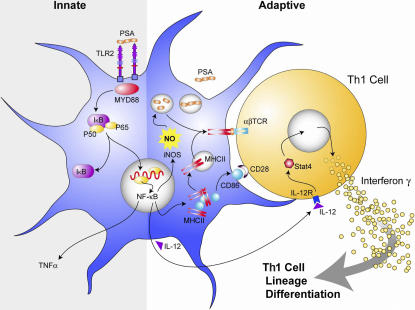Figure 7.
Proposed model for the intersection of innate and adaptive immunity during polysaccharide-induced abscess formation in the peritoneal cavity. The innate response begins with TLR2 recognition of PSA and the subsequent stimulation of the MyD88-mediated pathway inside the APC. NF-κB is translocated into the nucleus, stimulating the transcription of several important genes, including TNF-α. TNF-α is secreted by the APC and up-regulates intracellular adhesion molecule 1 on the mesothelium. Meanwhile, NF-κB translocation also leads to enhanced iNOS expression as well as up-regulation of MHCII and CD86, thus facilitating PSA processing and presentation by MHCII proteins. Presentation of PSA on the cell surface by MHCII leads to adaptive CD4+ T cell activation and T cell secretion of IFN-γ. IFN-γ production by the T cell is optimized by TLR2-mediated IL-12 production by the dendritic cell. This figure illustrates the interplay among innate signals and the shaping of the adaptive response for a common purpose: IFN-γ production.

